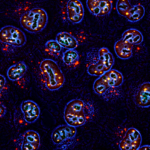Link to Pubmed [PMID] – 8993981
Genes Chromosomes Cancer 1997 Jan;18(1):59-65
Comparative genomic hybridization (CGH) was used to evaluate and map genomic aberrations in 50 hepatocellular carcinomas (HCCs) from patients chronically infected with hepatitis B virus (HBV). CGH clearly detected nonrandom genomic imbalances. Losses were most prevalent on chromosome regions 4q (70%), 8p (65%), 16q (54%), 17p (51%), 13q and 6q (37% each), and lp (30%). The most frequent gains occurred on 8q (60%), 1q (58%), and 6p and 17q (33% each). In a few cases, sequence amplifications were detected that were mapped to bands 11q12, 12p11, 14q12, and 19q13.1. This study represents the first analysis of primary liver cancers by CGH, and it confirms the presence of previously known chromosomal aberrations in HCC and highlights new quantitative abnormalities and sequence amplifications. These findings should lead to the characterization of new loci involved in liver cancer pathogenesis.

